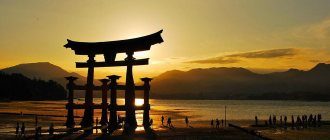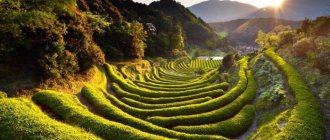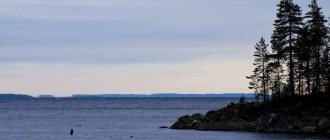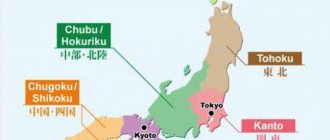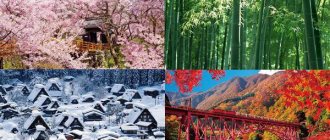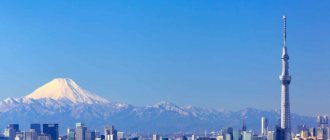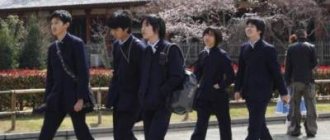Economic and geographical position of Japan
The western part of the Pacific Ocean concentrates on a large water area the islands of Honshu, Kyushu, Hokkaido, Shikoku and many other small islands that are part of one state.
The country's coordinates are: 35° 41' 7″ (35° 41' 12) and 139° 45' 11″ (139° 45' 18).
The north of Japan is washed by the Sea of Okhotsk, the south and east by the Pacific Ocean, and the western part is washed by the Sea of Japan.
Despite its own territorial alienation, Japan is located at the crossroads of world trade routes. Having such features of natural location, it carries out mutually beneficial trade with partner countries, including neighboring countries.
Sea of Okhotsk
(Cape on the Nemuro Peninsula, Hokkaido Islands region)
The Sea of Okhotsk was previously called Kamchatka. The Japanese call it Hokkai - North Sea. Its area is 1,603 square kilometers, and its maximum depth is almost 4 thousand meters. In winter (from October to May) it is covered with ice. But the southern part, located near Japan, almost never freezes. The waters of the Sea of Okhotsk are used for fishing. Japan owns only a small part of the waters near Hokkaido.
Capital and cities of Japan
The city of Tokyo, which includes several cities and a number of settlements, is the capital of Japan. But this was not always the case; the older city of Kyoto was the capital of Japan for many years.
The density of cities is high, and the cities themselves are classified into:
- cities defined by government decrees - 20 (the population in which exceeds 500 thousand people);
- central cities – 54;
- special cities - 31;
- cities – 683;
- special areas of Tokyo that have city status - 23.
Language
Most residents of Japan speak the official language - Japanese, which consists of ideography and syllabic phonography.
An unusual property of the language is the presence in it of honoratives, that is, various “forms of politeness” that reflect the hierarchical background of the social structure of the state.
Currency
The identity of the Japanese state includes one more item - currency. The national currency of the country of young rice sprouts is the yen.
The currency is quite cheap, since 100 yen cannot buy even one American dollar. You can change foreign currency at any bank.
Visa
If we touch on the issue of foreigners, it should be noted that Russians cannot enter Japan without a visa.
However, Japan has simplified visa conditions for Russian citizens compared to 2021.
Time
Time zones between countries have a 6-hour difference, with Russian delay.
Flag
The sun is truly a symbolic sign for the Japanese. The flag fully identifies Japan with the place where people are the first to see the sunrise.
Coat of arms (chrysanthemum) and flag of Japan
On the white canvas there is a red circle, a symbol of the sun's glow.
Religion
Most of the nation are staunch Buddhists and Shintoists. Before World War II, Shinto was the official religion, but after the war, Buddhism returned, making citizens believers of two religions simultaneously.
What changes occurred with the size of the territory?
The type of company that today triumphs in this sector is the one that manages to cut the costs of intermediaries, having in the same direction the design, production and sale of clothing and applying a system of rapid response, taking care of the rapid change of trends.
The Japanese market opened its doors, and internationalization allowed many foreign companies to enter, either through licensed manufacturing contracts, joint ventures, or opening their own stores. Companies in this sector are numerous because it is a very fragmented market, dominated by small and specialized companies in one or more sectors.
If you don’t remember the historical data, then I’ll refresh your memory. In the distant years 1910-1945, the territory of Japan was larger than the whole of Korea. Korea was a Japanese colony almost until the end of the well-known bloody war. But closer to the end of hostilities, the empire had to abandon it and return independence to Korea.
After the end of World War II, the area of the islands again adjusted somewhat, or rather, decreased. Japan was deprived of part of its territory.
The Japanese food, tobacco and beverage industry is a major manufacturing sector. There are numerous companies that compete to gain a share of this large market of 127 million people. The presence of imported goods is becoming stronger. Agriculture and fishing have long played an important role in the Japanese economy.
However, in recent times the industry has developed in parallel with the modernization of Japan and has brought many farmers to commercial and industrial cities. Fields close to major cities became residential areas. For some time, the lifestyle and diet in Japan had been largely Westernized, so many foods were imported from around the world, especially from the United States.
It also needs to be said that in 1879 the country increased somewhat due to its annexation. Which later became the current Japanese province of Okinawa.
Territory
— 377.8 thousand km 2
As an island country, fishing has always provided the Japanese with a major source of protein. Industrial fishing, very modern, is still an important activity for this country. Livestock farming has been expanding recently, but large quantities of meat must be imported to meet consumer needs. Iron and steel: About nine thousand tons of iron ore are imported annually for the production of cars, boats, etc. we can say that steel production is closely related to the development of industries.
Transformation: The manufacturing industry is the center of industrial activity in Japan. Machine tools, sewing machines, cars, boats, cameras and watches are the main products of this industry and are very good export products. Automobiles: The automobile industry is a significant part of the manufacturing industry and is the most important in terms of products produced in the country. Japan has become the second country in the world in car production.
Population
- 125.2 million people (1995).
Population of Japan
According to the latest census of 2005, the population of Japan was about 127 million 400 thousand people,
given the small area of the country.
At the same time, the national composition and the overwhelming majority, which is 99%, are ethnic Japanese, whose educational level is the highest in the world. Residents of the country came to this in the 19th century, despite the lack of agricultural opportunities, as well as the scarcity of mineral resources.
Comparison with Asian neighbors
If you try to compare with China, then, undoubtedly, it wins. After all, 9,596,961 km² is a significant number. Of course, there are many Chinese in the world, and such a number of people must live over a very large territory.
They are not limited to assessing financial risks and approving requested loans, but are involved in the activities of companies as well as their financial management. The long crisis in the Japanese economy since the mid-1990s largely destroys these specific elements. Likewise, the proportion of undertakings that keiretsu companies carry out with group members is decreasing. The automotive industry continues to be a major exporter and one of the pillars of the manufacturing sector.
This process of globalization has led to a weakening of the keiretsu in this sector. Manufacturers, coupled with the need to buy more competitive automotive components, no longer respect the known links associated with their suppliers. Component manufacturers, for their part, must now survive without the safe haven of keiretsu by accepting capital injections from multinational manufacturers or forming strategic alliances with foreign companies.
Thailand is also significantly larger than the samurai state, it stretches over 513,120 km². Thailand, with its gorgeous nature and fabulous sea, could also add several beautiful islands. But Vietnam is a little smaller than its neighbors. As for Malaysia, it is almost the same in size. Compact and interesting.
And North and South Korea, even if you put them together, will still be smaller than Japan, though only slightly. As we can see, among its neighbors, the homeland of anime looks respectable.
There is also rapid development of products related to the telecommunications sector, such as personal computers, mobile and information processors. Japan is one of the world's leading manufacturers of machine tools. The trend toward company automation promises sustainable growth for this sector in the long term. This is due to factors such as the need to rationalize production and integrate quality control into production.
Climate of Japan
The variety of landscapes and relief make Japan attractive to tourists, using all recreational resources.
Here foreigners will be able to see: hot springs, waterfalls, gorges and snowy mountain peaks.
The climate is not the same in opposite corners of the country. Moderately maritime in the northern islands and tropical in the south. This feature is explained by the length of the Japanese islands.
Their location at the junction of lithospheric plates leads the islands to constant seismic movement; they often suffer disasters from earthquakes.
Natural resources
The country demonstrates that rare example when neither the lack of natural resources nor modest agricultural opportunities stand in the way of the economic development of the state.
Japan's resource availability allows only 70% of its population to be supplied with food. Water, plant, fossil, and land resources are insufficient to create 100% self-sufficiency of the country.
Due to the mountainous terrain, forest resources are too limited, so annual artificial planting of vegetation helps to fill the missing potential.
Russian-Japanese relations
Throughout the twentieth century, relations between Russia and Japan developed in different ways - there were wars, and periods of calm and mutually beneficial relations. The main point of contention between the neighboring powers has always been the Kuril Islands and the southern part of Sakhalin, which the Japanese side considers to be their historical territories. Now Japan demands the return of the four southern islands of the Kuril chain (Iturup, Kunashir, Shikotan, Habomai), and recognizes Sakhalin as completely Russian territory.
The modern achievements of the Japanese economy inspire admiration and respect. For Russia's economic development, it is important to study and adopt the experience of such successful countries as Japan.
Agriculture
The territory of Japan is penetrated by many rivers and lakes that are not suitable for navigation. But they are skillfully used by the population to irrigate fields.
Fast-flowing rivers and other water resources support the hydroelectric industry, and lakes support the agricultural industry. Farmers mainly grow rice, legumes and tea.
